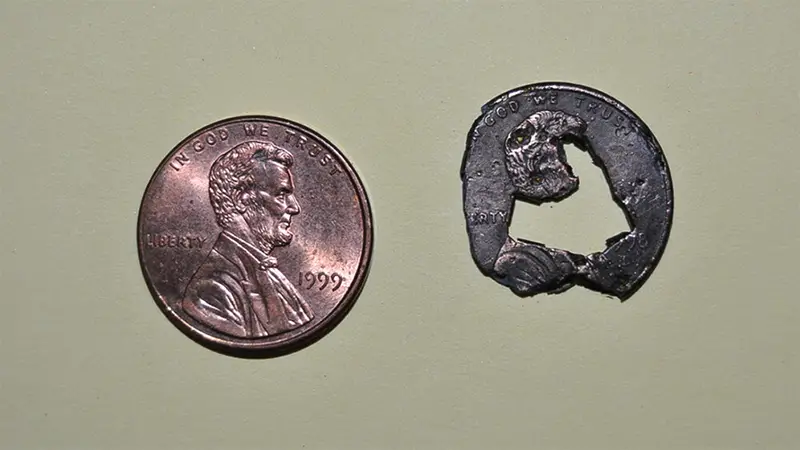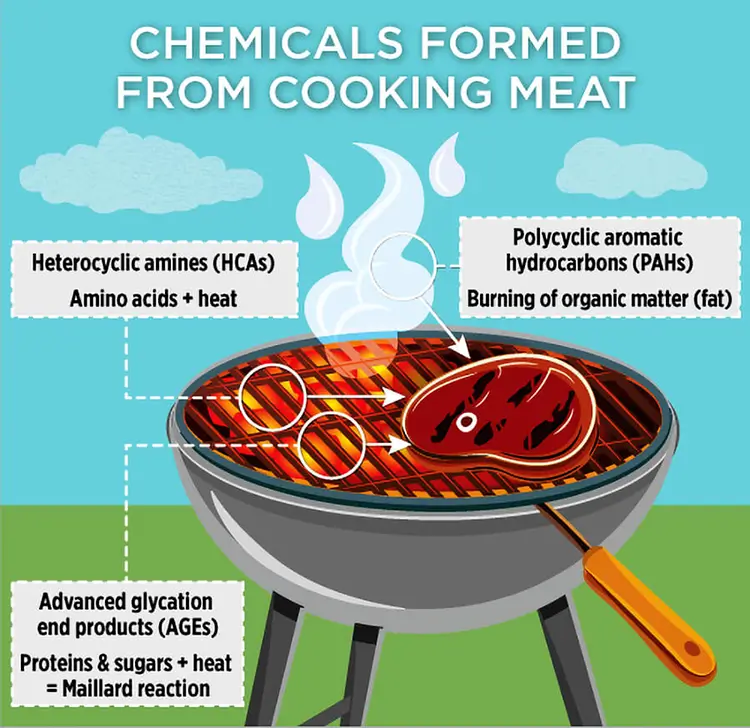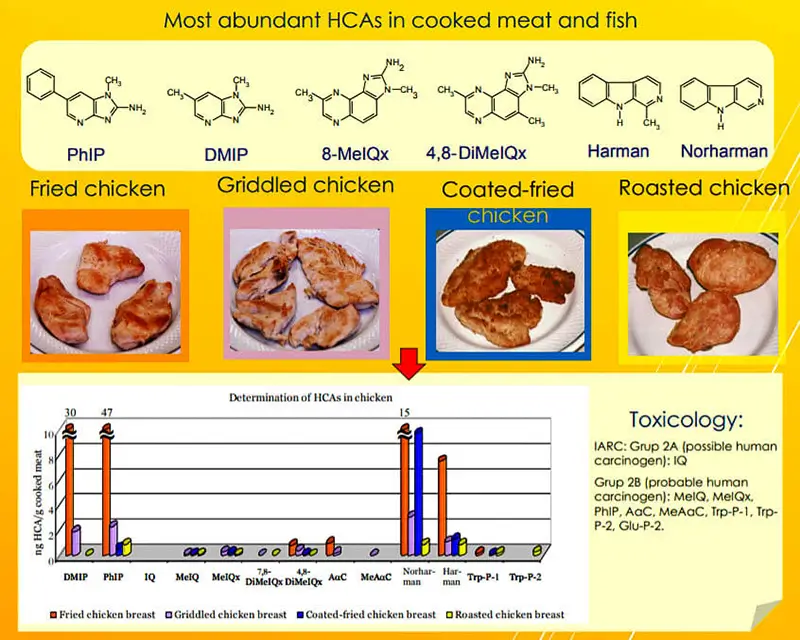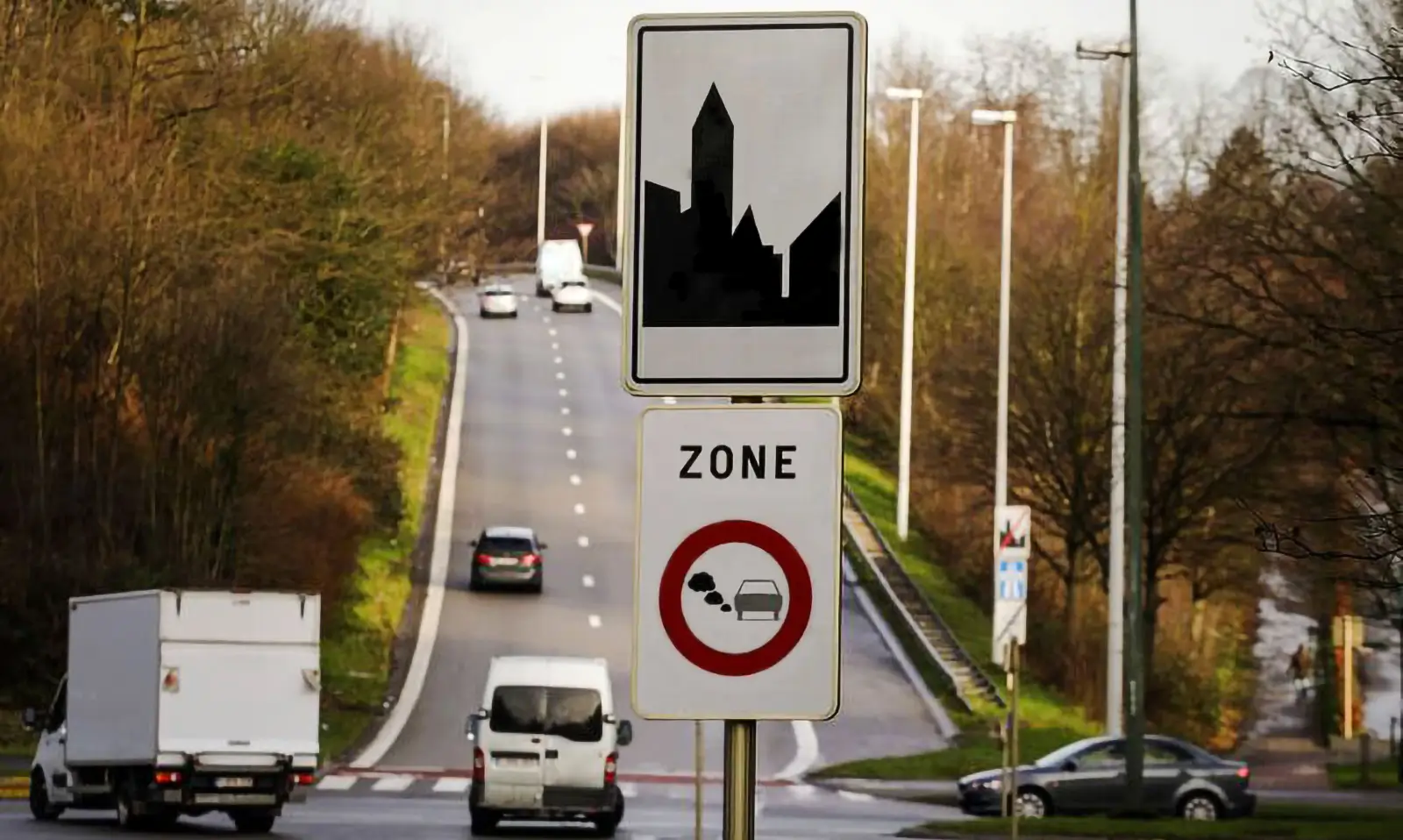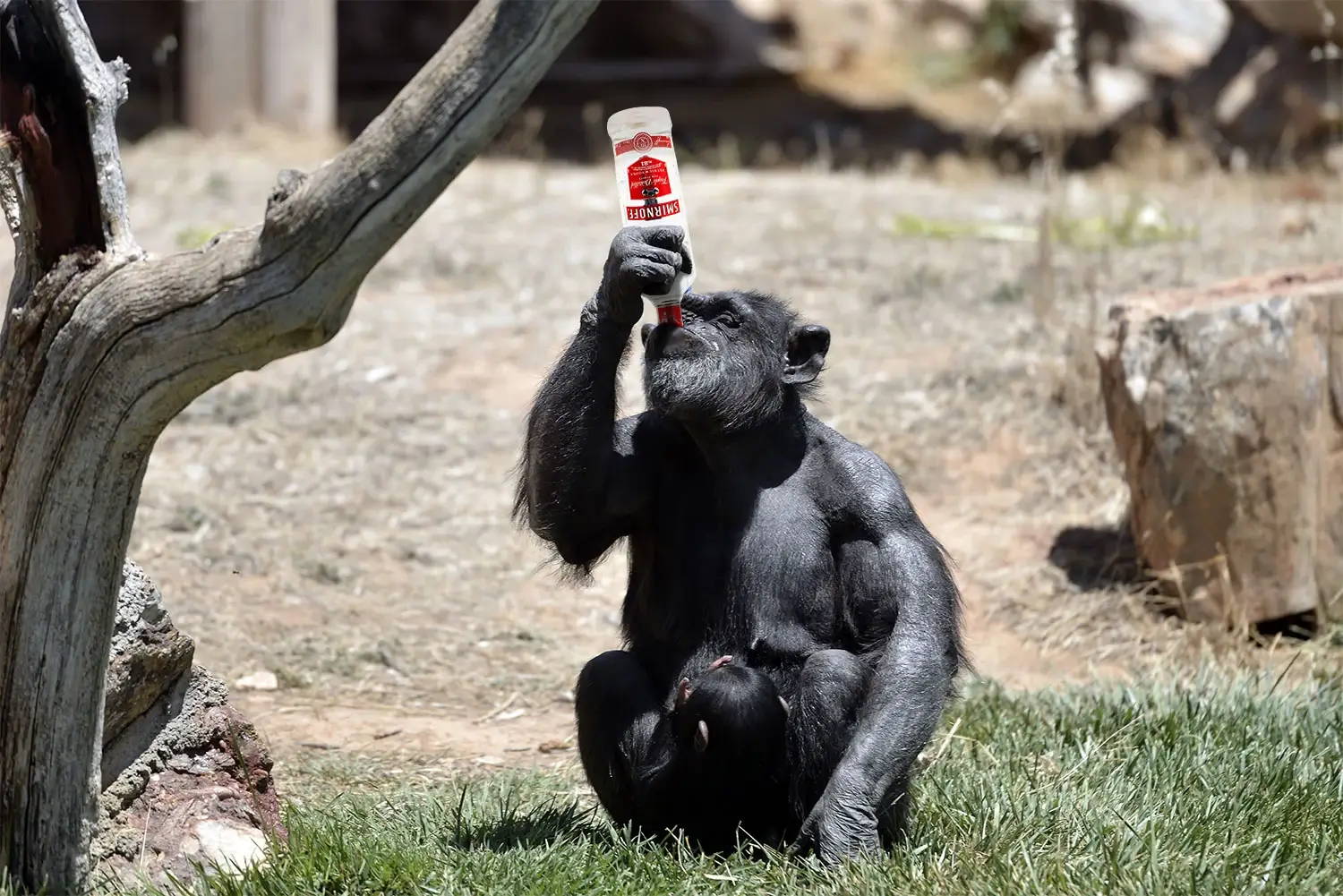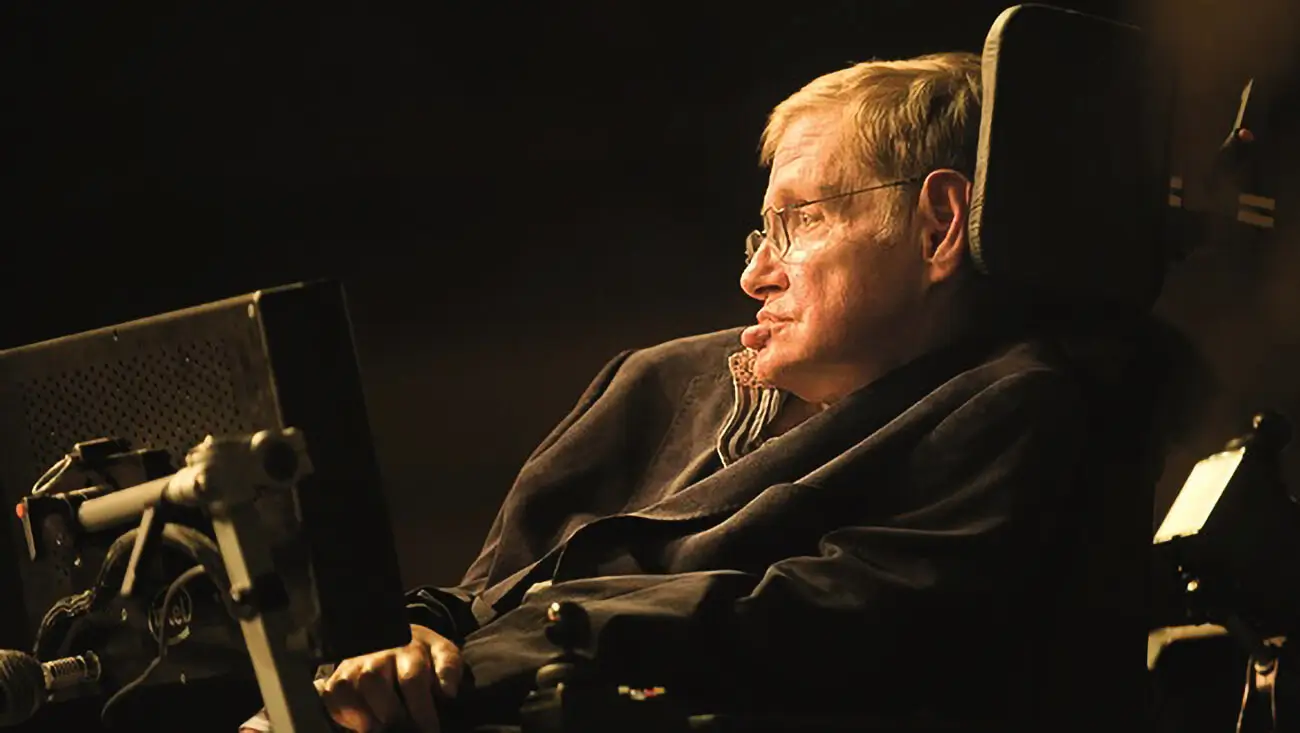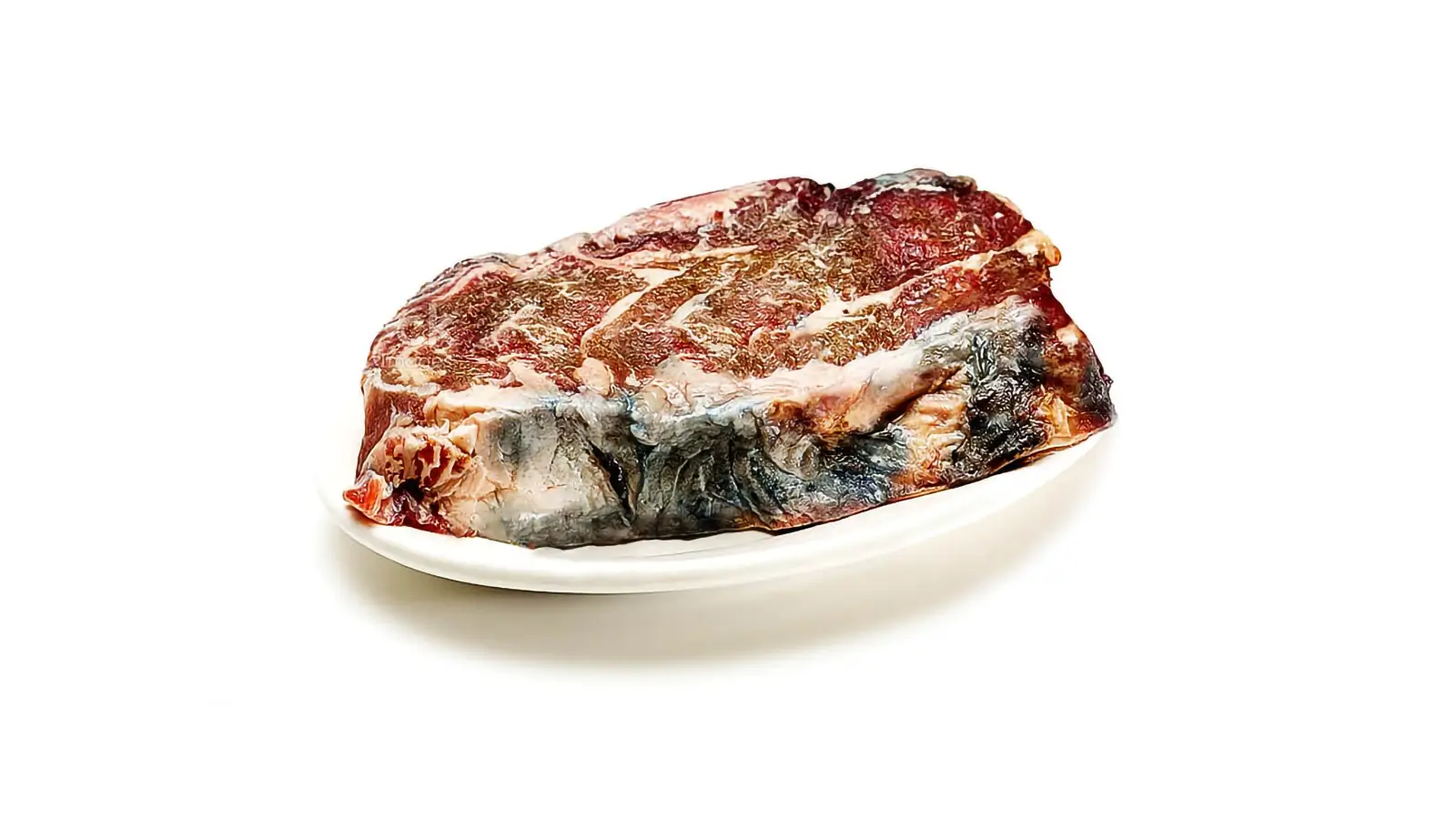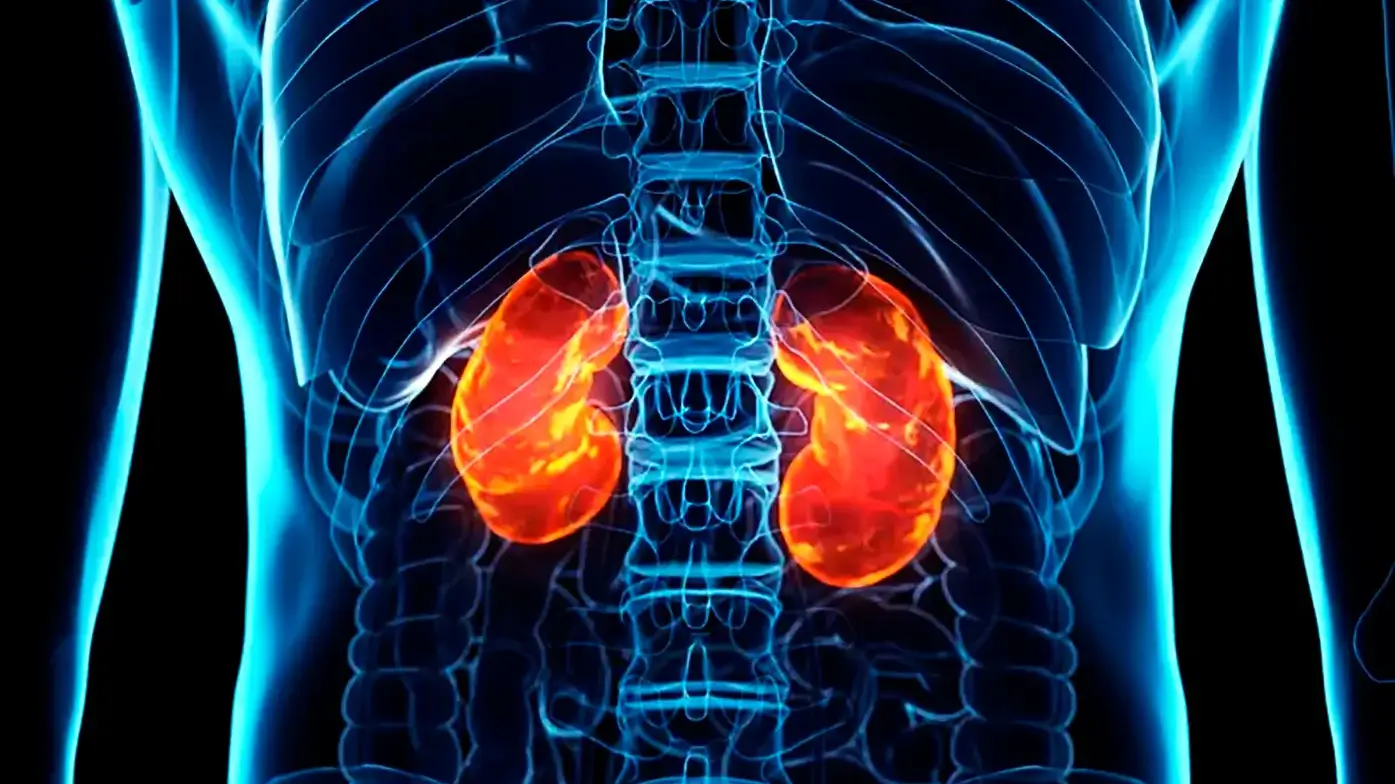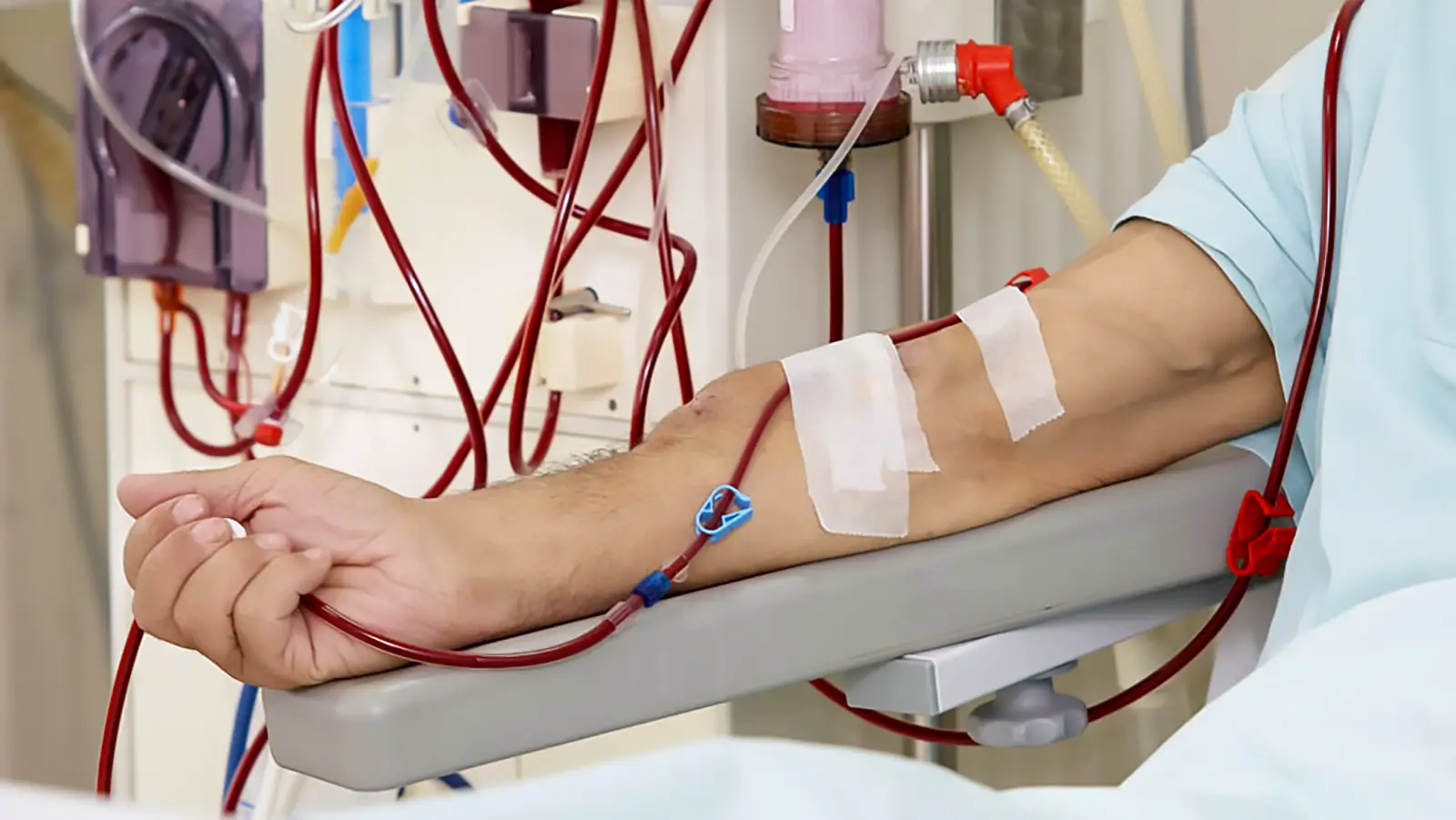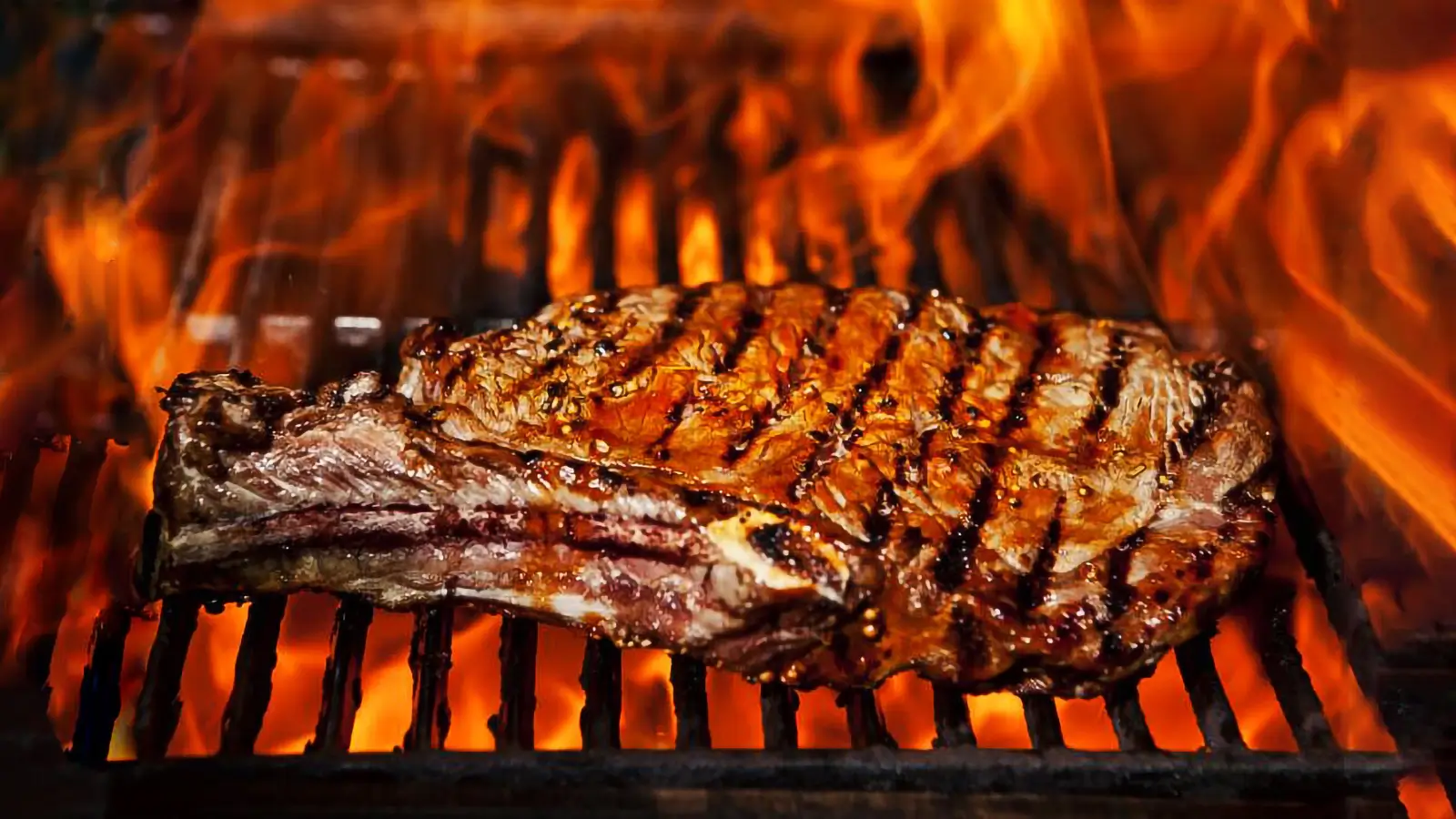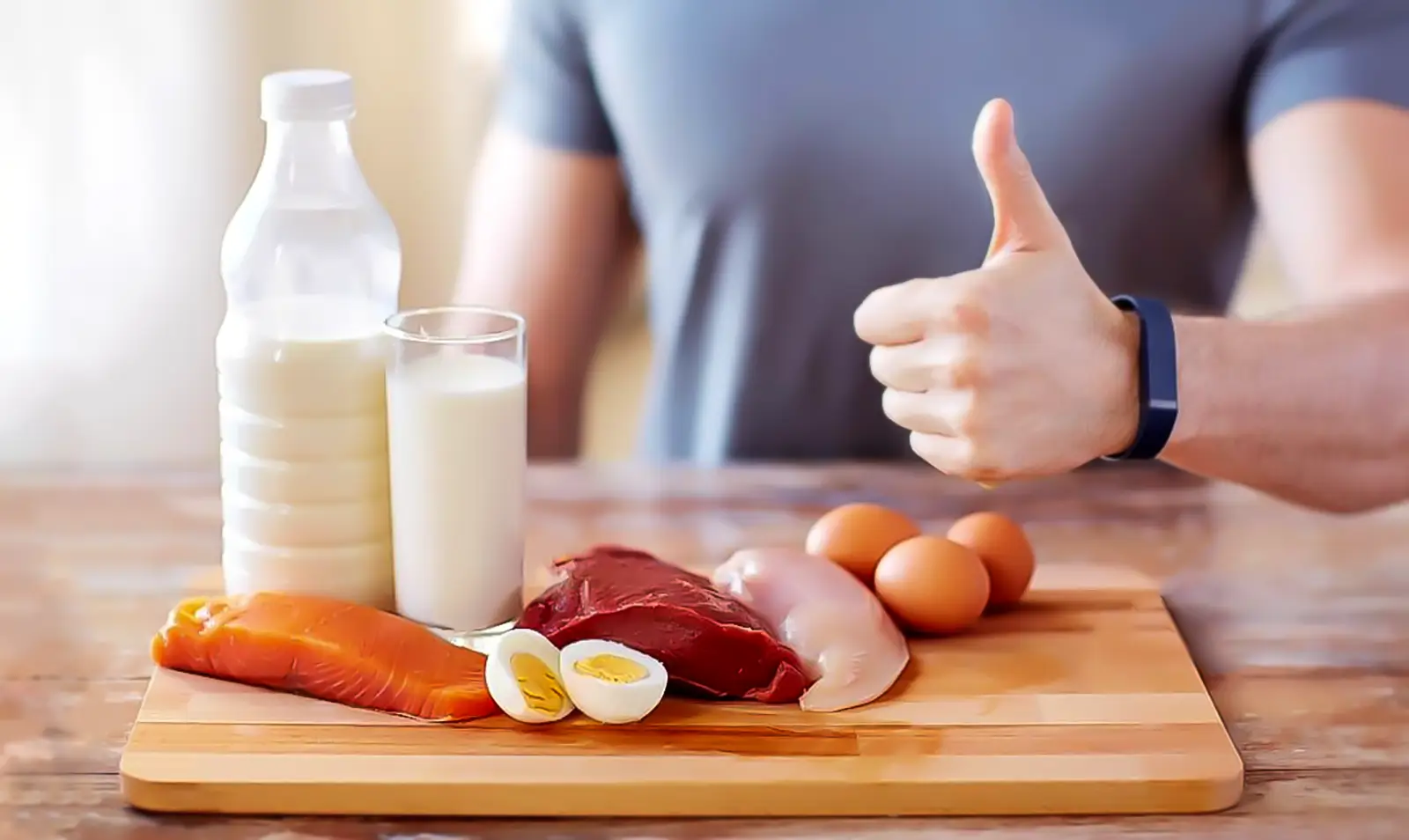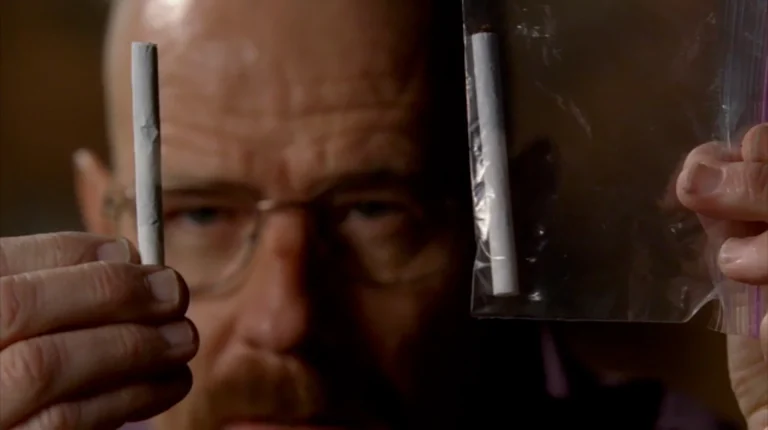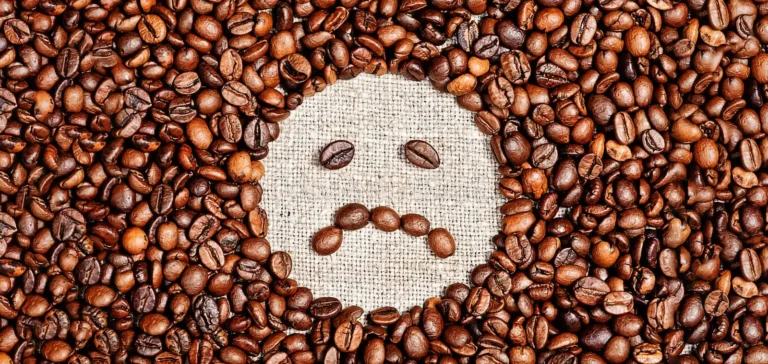La Carne cocida - El Mutágeno en un Bocado, Aminas Heterocíclicas Exposición
El calentamiento de aminoácidos en presencia de creatina (carne cocinada) crea mutágenos conocidos como aminas heterocíclicas (HCA).
Milos Pokimica
Escrito por: Milos Pokimica
Revisado Médicamente Por: Dr. Xiùying Wáng, M.D.
Actualizado el 9 de junio de 2023No se conoce ningún animal en la naturaleza, excepto los humanos modernos, que ase carne. No se trata de un proceso evolutivo congruente que esté provocando una grave inadaptación.
El calentamiento de aminoácidos en presencia de creatina y azúcares monosacáridos crea mutágenos conocidos como Aminas Heterocíclicas (HCA). Nuestro cuerpo no los reconoce como diferentes y los integra en las células. Estos aminoácidos se han dañado debido al calentamiento y su forma molecular ha cambiado. Esta integración en las células sanas provoca mutaciones en el ADN. El cáncer es una de las muchas enfermedades correlacionadas.

La gente paleo a la que le gusta la carne magra olvida de alguna manera que en el periodo paleo la mayoría de la gente prehistórica no vivía lo suficiente como para morir de enfermedades cardiovasculares o cáncer o padecer enfermedades crónicas. En condiciones extremadamente duras donde la esperanza de vida media es de 32 años, los genes que se transmiten a las generaciones más jóvenes son los que tienen la edad suficiente para llegar a la edad reproductiva por cualquier medio necesario. Eso significa no morir de inanición, de enfermedad o en un atentado. Cuantas más calorías consumamos, mejor, sean las que sean. El vínculo con el cáncer de carne no es realmente preocupante.
Comer carne cruda de cadáveres en descomposición no es nuestro alimento. En las condiciones climáticas de África, la carne tardaría sólo un par de horas en estropearse.
Las especies carnívoras hacen frente a los microorganismos nocivos con una fuerte acidez estomacal. La capacidad del estómago de los carnívoros para emitir ácido clorhídrico es extraordinaria. Los carnívoros pueden mantener su pH gástrico hasta alrededor de 1 ó 2, incluso con presencia de alimentos. Un pH gástrico fuerte facilita la descomposición de las proteínas y es necesario para matar la abundante cantidad de microorganismos peligrosos que suelen encontrarse en la carne en descomposición. Su tracto digestivo es estéril y no tienen colon grande para fermentar la fibra u otros alimentos. La carne se digiere en un par de horas y se excreta. En los animales carnívoros, el tiempo de tránsito es muy corto. Los tipos de bacterias en el intestino también son diferentes. Cuando comemos una manzana podrida, podemos emborracharnos, pero si comemos carne cruda en descomposición, existe una excelente posibilidad de sufrir graves consecuencias y morir.
En determinadas condiciones, cuando hay una necesidad absoluta, los animales herbívoros comerán la carne disponible sólo para sobrevivir. Y la carne tiene que estar cocinada.
Permítanme poner un ejemplo de cómo se producen y progresan las enfermedades crónicas para que podamos empezar a entenderlo. El trastorno del sistema nervioso más común de todos los trastornos neurológicos es algo llamado temblor esencial (TE). Suele consistir en un temblor involuntario de brazos, manos o dedos, pero a veces también puede afectar a la cabeza, las cuerdas vocales u otras partes del cuerpo. Es una afección distinta de la enfermedad de Parkinson, pero a menudo se diagnostica erróneamente como tal. En los casos más graves, la ET interfiere en las actividades cotidianas de la persona, como vestirse, ocuparse de la higiene personal, alimentarse, y suele ser progresiva en la mayoría de los casos. Algunas personas lo tienen en familias así que la genética juega un papel y desarrollarán síntomas a una edad temprana pero no es la mala genética el verdadero problema, y lo explicaré.
Lo que ocurre es que cuando calentamos aminoácidos (componentes básicos de las proteínas) en presencia de creatina y azúcares monosacáridos, se produce una reacción y los aminoácidos pierden su forma molecular.
Lo que esto significa es que son diferentes, pero no tanto, y ese es el problema porque nuestro cuerpo no los reconoce como diferentes. Piensa que son aminos normales. El cáncer de carne es una correlación causada por esta mutagenicidad de las Aminas Heterocíclicas (HCA) pero también lo son muchas otras condiciones diferentes.
Aún no estamos totalmente adaptados a nuestro nuevo estilo de vida y, como consecuencia, lo que ocurre es que empiezan a incorporarse a nuestras células. Como su estructura molecular es diferente, causa problemas en forma de mutaciones. Tener mutaciones puede parecer una buena idea para una película de SF, pero en la vida real mata.
Provoca cambios en el ADN. La carne calentada a altas temperaturas, especialmente por encima de 300 °F (como en la parrilla o la sartén), o que se cocina durante mucho tiempo, tiende a formar más de estas aminas heterocíclicas mutadas (HCA).
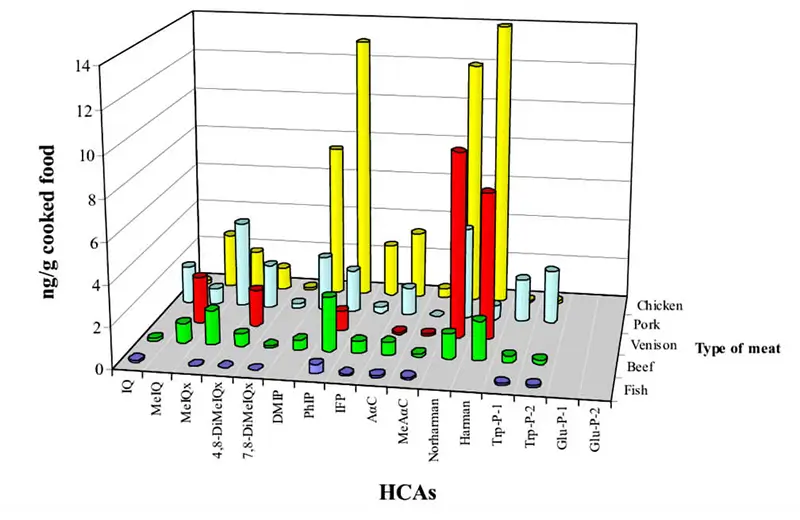
Por ejemplo, el pollo y el bistec bien hechos, a la parrilla o a la barbacoa tienen concentraciones extremas de aminas heterocíclicas (HCA). De hecho, el pollo es el peor de todos, con alrededor de dos veces más de este carcinógeno que la ternera o el cerdo. Marinar la carne antes de cocinarla con algún tipo de adobo rico en antioxidantes, como el ajo o el romero, parece ayudar. Un adobo de 20 g/100 g de ajo redujo la producción de carcinógenos en un 70%. En cambio, la salsa barbacoa normal que contiene mucho azúcar provocó un aumento significativo de la formación de sustancias químicas, triplicando los niveles tras 15 minutos de cocción.

Hay una lista de diferentes tipos de estas aminas heterocíclicas desordenadas que se crean en la carne cocinada. PhIP (2-Amino-1-metil-6-fenilimidazopiridina) es la más abundante. Estudios a largo plazo con roedores confirmaron que la PhIP provoca cáncer de glándula mamaria y de colon. La más tóxica y mutagénica de todas es la MeIQ. El MeIQ es precisamente 24 veces más cancerígeno que la aflatoxina, y ésta es una de las sustancias más tóxicas jamás creadas por el moho. Todas las demás, y hay más de 20 HCA, son más tóxicas que el benzopireno. El benzopireno es un carcinógeno primario que causa el mayor daño en los fumadores y se encuentra en el humo de los cigarrillos y en el alquitrán de hulla.
En realidad, el humo que se produce al mismo tiempo durante la cocción crea una lista de otros mutágenos diferentes denominados hidrocarburos aromáticos policíclicos (HAP). Las técnicas de cocción que exponen la carne al humo o a la carbonización contribuyen a la formación de HAP. Los HAP se crean con la cocción a alta temperatura de la carne. Por ejemplo, cuando la grasa y los jugos de la carne a la parrilla gotean y provocan llamas, los humos se llenan de HAP que luego se adhieren a la superficie de la carne. Cualquier forma de combustión puede crearlos, por ejemplo, el carbón, el petróleo, el gas, la madera, la basura y el tabaco también los tienen. También se forman cuando se utiliza humo, como en el ahumado de carnes.
Estos mutágenos no naturales (HCA y HAP) que se forman con actividades no naturales como asar a la parrilla son capaces de dañar el ADN debido a nuestra falta de adaptación a ellos. El organismo dispone de una línea de enzimas específicas para neutralizar estos mutágenos.
Los investigadores han descubierto que la acción de esas enzimas difiere significativamente entre las personas. Y eso es un problema. En los individuos que tienen niveles más bajos de estas enzimas, la exposición a estos compuestos puede asociarse a un aumento del riesgo de cáncer. Algunos de nosotros podemos hacer frente mejor a la desintoxicación de estos mutágenos y otros no pueden y tendrán un mayor riesgo de cáncer. Y eso es lo que en medicina se llama factor genético. No es que nazcamos con malos genes y ya está, tendrás cáncer o no. La situación es más complicada.
Por supuesto, cierto nivel de cáncer también se da en los animales, pero el 23,4% de todas las muertes no se deben a la genética. Es una epidemia de proporciones bíblicas porque es, en esencia, una forma de inadaptación a nuestro entorno.
Uno de los HCA que se forma es el Harmane. El Harmane es una neurotoxina fuertemente asociada a los temblores esenciales. Si se expone al ratón mediante inyección, desarrollará un temblor extremo en sólo 3,1 minutos después de la exposición y el temblor duraría horas. Al ser liposoluble, se acumula con el tiempo en todos los tejidos grasos, incluido el cerebro. Se encuentra en niveles elevados no sólo en el cerebro de los pacientes con ET, sino también en la enfermedad de Parkinson. En comparación con el grupo de control, la concentración de Harmane es precisamente un 50% mayor en el cerebro de los pacientes con temblor esencial. También es elevada en las muestras de sangre. Si hay un paciente que tiene antecedentes familiares de temblor esencial los resultados de los análisis de sangre muestran las concentraciones más altas de todas las personas.
El temblor esencial es una enfermedad de desintoxicación de las enzimas hepáticas, una forma de mala adaptación. Las personas con TE pero sin antecedentes familiares tendrán niveles un poco más bajos que las personas con antecedentes familiares, pero aún así muy por encima de los niveles normales. El Harmane elevado en ET es debido a una reducción heredada en la capacidad de metabolizarlo fuera del sistema. Igual que con cualquier otra enfermedad, algunas personas son más propensas algunas menos, pero ninguno de nosotros es inmune completamente. Por eso vemos que con el tiempo aumenta el porcentaje de personas con la enfermedad. Del 4% en los años 40 al 20% en los 90. Si conseguimos vivir lo suficiente la mayoría acabaremos contrayéndola, excepto las personas que no la consumen. Por cada 10 gramos/día adicionales de carne consumida, las probabilidades de TE aumentan un 6%.
Ahora usted puede ser que no consiga ET, todo el esto es apenas un ejemplo pequeño para la comprensión lógica. Puede que te dé cáncer. La verdadera dificultad es que hay una larga lista de diferentes enfermedades crónicas para elegir dependiendo de la genética individual.
Referencias:
Pasajes seleccionados de un libro: Pokimica, Milos. Go Vegan? Examen de Ciencias de la Parte 1. Kindle ed., Amazon, 2018.
- Hopfner, Franziska, y Rick C. Helmich. "La etiología del temblor esencial: Genes versus entorno". Parkinsonismo y trastornos relacionadosvol. 46, Elsevier BV, enero de 2018, pp. S92-96. https://doi.org/10.1016/j.parkreldis.2017.07.014.
- Louis, Elan D et al. "Dietary epidemiology of essential tremor: meat consumption and meat cooking practices". Neuroepidemiología vol. 30,3 (2008): 161-6. doi:10.1159/000122333
- Barzegar, Fatemeh et al. "Heterocyclic aromatic amines in cooked food: A review on formation, health risk-toxicology and their analytical techniques". Química de los alimentos vol. 280 (2019): 240-254. doi:10.1016/j.foodchem.2018.12.058
- Sanz-Serrano, J et al. "Evaluación de la genotoxicidad de la carne frita: Una revisión exhaustiva". Toxicología química y alimentaria: una revista internacional publicada para la Asociación Británica de Investigación Biológica Industrial vol. 136 (2020): 110943. doi:10.1016/j.fct.2019.110943
- Felton, J S et al. "Identificación de los mutágenos en la carne de vacuno cocida". Perspectivas de salud medioambiental vol. 67 (1986): 17-24. doi:10.1289/ehp.866717
- Heddle, J A et al. "A test of the mutagenicity of cooked meats in vivo". Mutagénesis vol. 16,2 (2001): 103-7. doi:10.1093/mutage/16.2.103
- Shin, Aesun et al. "Meat and meat-mutagen intake, doneness preference and the risk of colorectal polyps: the Tennessee Colorectal Polyp Study". Revista internacional del cáncer vol. 121,1 (2007): 136-42. doi:10.1002/ijc.22664
- Shabbir, Muhammad Asim et al. "Effect of thermal treatment on meat proteins with special reference to heterocyclic aromatic amines (HAAs)". Revisiones críticas en ciencia de los alimentos y nutrición. vol. 55,1 (2015): 82-93. doi:10.1080/10408398.2011.647122
- Alaejos, M S et al. "Exposure to heterocyclic aromatic amines from the consumption of cooked red meat and its effect on human cancer risk: a review". Aditivos alimentarios y contaminantes. Parte A, Química, análisis, control, exposición y evaluación de riesgos. vol. 25,1 (2008): 2-24. doi:10.1080/02652030701474235
- Pleva, Dániel et al. "Predictive Correlation between Apparent Sensory Properties and the Formation of Heterocyclic Amines in Chicken Breast as a Function of Grilling Temperature and Time". Alimentos (Basilea, Suiza) vol. 9,4 412. 2 de abril de 2020, doi:10.3390/foods9040412
- Zheng, Wei, y Sang-Ah Lee. "Ingesta de carne bien cocida, exposición a aminas heterocíclicas y riesgo de cáncer". Nutrición y cáncer vol. 61,4 (2009): 437-46. doi:10.1080/01635580802710741
Contenidos Relacionados
¿Tienes alguna duda acerca de la nutrición y la salud?
Me encantaría saber de usted y responderlas en mi próxima publicación. Agradezco sus aportes y opiniones y espero tener noticias suyas pronto. También te invito a síguenos en Facebook, Instagram y Pinterest para más contenidos sobre dieta, nutrición y salud. Puedes dejar un comentario allí y conectar con otros entusiastas de la salud, compartir tus consejos y experiencias, y recibir apoyo y ánimo de nuestro equipo y nuestra comunidad.
Espero que este post le haya resultado informativo y ameno y que esté preparado para aplicar los conocimientos adquiridos. Si le ha resultado útil, por favor compártelo con tus amigos y familiares que también podrían beneficiarse de ella. Nunca se sabe quién puede necesitar orientación y apoyo en su camino hacia la salud.
– También Te Puede Interesar –

Aprenda Sobre Nutricion
Milos Pokimica es doctor en medicina natural, nutricionista clínico, escritor sobre salud médica y nutrición y asesor en ciencias de la nutrición. Autor de la serie de libros Go Vegan? Revisión de la Ciencia, también dirige el sitio web sobre salud natural GoVeganWay.com.
Descargo De Responsabilidad Médica
GoVeganWay.com le ofrece reseñas de las últimas investigaciones relacionadas con la nutrición y la salud. La información proporcionada representa la opinión personal del autor y no pretende ni implica sustituir el asesoramiento, diagnóstico o tratamiento médico profesional. La información proporcionada tiene fines informativos únicamente y no pretende sustituir la consulta, el diagnóstico y/o el tratamiento médico de un médico o proveedor de atención médica calificado.NUNCA ignore el CONSEJO MÉDICO PROFESIONAL O RETRASAR la BÚSQUEDA de TRATAMIENTO MÉDICO a CAUSA DE ALGO QUE HAYA LEÍDO EN O accesibles a TRAVÉS de GoVeganWay.com
NUNCA APLICAR CUALQUIER cambio de ESTILO de vida O CAMBIOS EN su totalidad COMO UNA CONSECUENCIA DE ALGO QUE HA LEÍDO EN GoVeganWay.com ANTES de CONSULTAR con LICENCIA PROFESIONAL MÉDICO.
En el caso de una emergencia médica, llame a un médico o al 911 inmediatamente. GoVeganWay.com no se recomienda ni aprueba ninguna de los grupos, las organizaciones, las pruebas, los médicos, productos, procedimientos, opiniones u otra información que pueda ser mencionado en el interior.
Selecciones del editor –
Milos Pokimica es escritor especializado en salud y nutrición y asesor en ciencias nutricionales. Autor de la serie de libros Go Vegan? Revisión de la Ciencia, también dirige el sitio web sobre salud natural GoVeganWay.com.
Últimos artículos -
Top Noticias De Salud — ScienceDaily
- A surprising brain cleanup reduced epileptic seizures and restored memoryen diciembre 26, 2025
A new study suggests temporal lobe epilepsy may be linked to early aging of certain brain cells. When researchers removed these aging cells in mice, seizures dropped, memory improved, and some animals avoided epilepsy altogether. The treatment used drugs already known to science, raising the possibility of quicker translation to people. The results offer new hope for patients who do not respond to existing medications.
- This popular painkiller may do more harm than gooden diciembre 25, 2025
Tramadol, a popular opioid often seen as a “safer” painkiller, may not live up to its reputation. A large analysis of clinical trials found that while it does reduce chronic pain, the relief is modest—so small that many patients likely wouldn’t notice much real-world benefit. At the same time, tramadol was linked to a significantly higher risk of serious side effects, especially heart-related problems like chest pain and heart failure, along with common issues such as nausea, dizziness, […]
- Scientists found a way to restore brain blood flow in dementiaen diciembre 25, 2025
A new study suggests that dementia may be driven in part by faulty blood flow in the brain. Researchers found that losing a key lipid causes blood vessels to become overactive, disrupting circulation and starving brain tissue. When the missing molecule was restored, normal blood flow returned. This discovery opens the door to new treatments aimed at fixing vascular problems in dementia.
- Scientists reverse Alzheimer’s in mice and restore memoryen diciembre 24, 2025
Alzheimer’s has long been considered irreversible, but new research challenges that assumption. Scientists discovered that severe drops in the brain’s energy supply help drive the disease—and restoring that balance can reverse damage, even in advanced cases. In mouse models, treatment repaired brain pathology, restored cognitive function, and normalized Alzheimer’s biomarkers. The results offer fresh hope that recovery may be possible.
- Why consciousness can’t be reduced to codeen diciembre 24, 2025
The familiar fight between “mind as software” and “mind as biology” may be a false choice. This work proposes biological computationalism: the idea that brains compute, but not in the abstract, symbol-shuffling way we usually imagine. Instead, computation is inseparable from the brain’s physical structure, energy constraints, and continuous dynamics. That reframes consciousness as something that emerges from a special kind of computing matter, not from running the right program.
- This tiny peptide could help stop brain damage after injuryen diciembre 24, 2025
A four–amino acid peptide called CAQK has shown powerful brain-protective effects in animal models of traumatic brain injury. Delivered through a standard IV, it zeroes in on injured brain tissue, calming inflammation and reducing cell death while improving recovery. The peptide worked in both mice and pigs, whose brains are closer to humans in structure. Researchers are now preparing to move toward early human clinical trials.
- These nanoparticles kill cancer cells while sparing healthy onesen diciembre 24, 2025
Researchers have created tiny metal-based particles that push cancer cells over the edge while leaving healthy cells mostly unharmed. The particles work by increasing internal stress in cancer cells until they trigger their own shutdown process. In lab tests, they killed cancer cells far more effectively than healthy ones. The technology is still early-stage, but it opens the door to more precise and gentler cancer treatments.
PubMed, #Dieta vegana –
- Dementia Care Research and Psychosocial Factorsen diciembre 25, 2025
CONCLUSION: Around 2% of the world’s population is homozygous for APOE4, making it increasingly rare for three siblings within one family to present with this genetic makeup, two of whom go on to develop early onset Alzheimer’s disease. Further medical testing is warranted regarding the current patient’s cognitive status and biomarkers for Alzheimer’s Disease. This case study could contribute to a greater understanding of protective lifestyle changes that delay Alzheimer’s disease, […]
- Comparing diet-related attitudes, perceptions, and behaviors of vegan and omnivorous adults: results from a cross-sectional survey study in Germanyen diciembre 22, 2025
CONCLUSION: The findings are consistent with and build on existing research on cognitive and behavioral patterns related to a vegan diet, while at the same time yielding some additional insights. In particular, the results on significant differences in the risk-benefit perception of a vegan diet, as well as on motivations and influences regarding the decision to follow a vegan diet provide an important basis for the development of public health interventions and a foundation for further […]
- Assessment of vitamin A, vitamin B2, vitamin B12, vitamin K, folate, and choline status following 4 months of multinutrient supplementation in healthy vegans: a randomised,…en diciembre 19, 2025
CONCLUSION: A multinutrient supplement containing 82 µg of vitamin B(12) per day significantly positively affected vitamin B(12) blood biomarkers in healthy vegans.
- Exploring the synergistic potential of pH and ultrasonication on the functional properties of pea and lentil protein isolates and its formulation in food producten diciembre 15, 2025
The substitution of meat proteins with plant-based proteins from various sources is often motivated by nutritional considerations. However, the inherent limited solubility of plant proteins, which results in suboptimal techno-functional properties, remains a persistent challenge in food formulation. The purpose of this study was to utilize unique properties of pea (Pisum sativum L.) and lentil (Lens culinaris) through ultrasonication and pH variation in order to develop a stable and […]
- Functional and Nutritional Properties of Lion’s Mane Mushrooms in Oat-Based Desserts for Dysphagia and Healthy Ageingen diciembre 11, 2025
Hericium erinaceus (Lion’s Mane mushroom) is a medicinal species recognised for its neuroprotective and antioxidant properties. This study investigated its potential as a functional ingredient in oat milk-based desserts formulated for individuals with dysphagia. Freeze-dried Lion’s Mane powder (LMP), containing high-quality protein (~16%, amino acid score 88%), dietary fibre (~31%), and phenolic compounds (72.15 mg GAE/g), was incorporated at varying levels using gelatin or iota-carrageenan […]
Publicaciones aleatorias –
Publicaciones destacadas -
La última versión desde PubMed, #Dieta basada en plantas –
- Seasonal Dietary Patterns of Tarim Red Deer (Cervus hanglu yarkandensis) Revealed by the trnL Sequencing Approach in the Tarim River Basin (Xinjiang, China)por Cheng Qi en diciembre 25, 2025
The Tarim red deer (Cervus hanglu yarkandensis) is a flagship species inhabiting the Euphrates poplar (Populus euphratica) riparian forests along the Tarim River in China. It is listed as a Class I nationally protected species but despite its importance, current knowledge about this subspecies remains limited, particularly regarding the seasonal variation in its foraging ecology within the Shaya region of Xinjiang-a landscape characterized by a mosaic of Euphrates poplar forests interspersed…
- The potential of immature jackfruit in meat analoguespor Anne C M Swinkels en diciembre 24, 2025
The jackfruit, the fruit of the jackfruit tree ( Artocarpus heterophyllus ), is a unique tropical fruit. While sweet and fruity in its ripe form, in its immature form, the jackfruit flesh mimics the texture of meat, making it an increasingly popular plant-based meat analogue. To reach its full potential as an ingredient for meat analogues, a better understanding of the immature fruit properties in relation to its behaviour in food products is required. This review focuses on immature […]
- The 3V score and joint associations of low ultra-processed food, biodiverse and plant-based diets on colorectal cancer risk: results from the European Prospective Investigation into Cancer and…por Emine Koc Cakmak en diciembre 24, 2025
BACKGROUND: Diet may modify colorectal cancer risk. We investigated the associations of three dietary patterns, ultra-processed food (UPF) consumption, healthy plant-based food consumption, and food biodiversity, separately and combined into a “3V” score with risk of colorectal cancer.
- Lifestyle-Based Approaches to Cancer Prevention and Treatment: Diet, Physical Activity, and Integrative Strategiespor Gianpiero Greco en diciembre 24, 2025
Cancer remains a leading global cause of morbidity and mortality. Modifiable lifestyle factors, including avoidance of tobacco use and excessive ultraviolet radiation, healthy dietary patterns, regular physical activity, and weight management, play key roles in prevention and care. This narrative review synthesizes evidence on lifestyle-based interventions influencing cancer risk, treatment tolerance, and survivorship. A literature search was conducted in PubMed and Scopus, supplemented by…
- Protection of clove extract against Salmonella enteritidis-induced intestinal dysfunction in broilers through JAK2/STAT3-mediated stem cell activationpor Yuqing Feng en diciembre 24, 2025
Salmonella enteritidis(SE) is a major pathogenic bacterium causing intestinal epithelial tissue damage in broiler chickens raised without antibiotic supplementation. Clove extract, as a natural antibacterial agent, possesses activity against bacterial invasion and improves intestinal health. However, the mechanism by which clove extract alleviates SE infection remains unclear. This study aimed to elucidate the protective effects of clove extract and its underlying mechanism against SE-induced…
- Public Healthpor Emily A Johnston en diciembre 23, 2025
CONCLUSION: Mean observed MIND diet and Veggie Meter scores show less than desirable intake of carotenoid-rich foods for reduction of AD/ADRD risk among participants. The majority of participants take dietary supplements, and few consume a diet supportive of brain health. Few cohort studies include subjective and objective diet assessments with actionable feedback for participants. These preliminary findings emphasize the need for further research into dietary interventions for prevention or…
